
What you need to get a small business loan
Applying for a small business loan is one of the most common ways to get funding. According to a Federal Reserve report, almost half (40%) of U.S. business owners applied for a loan in 2017.
Whether you need financing to get your new business up and running, some extra funds to expand your operations, or an influx of money to boost your cash flow, a small business loan can serve as an excellent option for entrepreneurs.
But you can’t just walk into your local bank and expect to immediately walk out with cash in hand. To successfully obtain a small business loan, you’ll have to do some homework to earn the trust of your chosen lender.
Navigating the complex application process can be daunting. But never fear—here, we’ve gathered all the info to help you compile all your legal and financial paperwork and set yourself up for success.
What lenders want: Establish yourself as the perfect loan candidate
Before you even begin the application process, small business owners should do some research. You’ll need to figure out some basics about the kind of loan you’re seeking and the financial institution or online lender you want to approach.
To better inform your research, it’s helpful to understand what makes a great loan candidate in the eyes of lender. Typically, they’re looking for:
- Credibility. Banks want to know that your business will succeed or is in great shape currently. They want to know that you have your finances together so that you have the means to repay the loan. That translates to a good credit rating and a solid business plan.
- Character. Banks and other lenders want to, above all, ensure they’ll get their money back. To establish that business owners have a good “financial character,” lenders want to see that you repay debts in full and on time. That means no late payments or delinquent accounts on your credit history.
- Collateral. To get a secured loan, entrepreneurs need to put up their own assets as collateral. That way, if you default on your small business loan, they have something to cover their financial loss. Collateral, which almost serves as a down payment, can take the form of revenues from your business or personal assets like your home.
- Capital. When you approach a lender, you’ll need to come prepared with a list of business assets. Whether that takes the form of cash, equipment, or facilities, lenders want proof that your business is successful and can stay afloat while you repay their loan.
Prepping your application: Do your homework
Now that you understand what banks and other lenders are looking for, it’s time to start your own digging. Here are some of the keys things you’ll need to prepare for your application.
Decide where you want to get your loan
While most business owners still approach traditional financial institutions like national banks for a loan, more entrepreneurs are leaning on local banks, credit unions, microlenders, and online lenders. Do some research into what lender you’d prefer to work with.
Typically, businesses seeking larger loan amounts play it safe by borrowing from bigger banks while more entrepreneurs seeking smaller loans approach alternative lenders like peer-to-peer marketplaces.

Image: Finder.com/SBA
Decide on a type of loan
Yes, you’re seeking a small business loan—but there are a dozen or more varieties that depend on your business and your needs. For example, if you’re starting a new business or if it’s less than a year old, consider a startup loan. If you need to replace or add to your fleet of equipment, look into equipment financing.
Eligibility requirements for your chosen loan lender
When researching your preferred lender, you’ll need to hone in your research on their specific requirements to obtain a loan. Some of the most common prerequisites include information on how long you’ve been in business, your credit rating, annual revenues, and proof of ability to pay (i.e., detailed financial statements). Whatever the requirements, make sure you have everything you need before applying.
Pull your credit information
Don’t go into a bank meeting blind when it comes to your credit. Pull your credit report prior to submitting your formal loan application. You’ll be able to review it ahead of time to ensure there aren’t any errors and to make sure you meet minimum credit requirements (many banks require a score of at least 680 for a small business loan).
Make sure your loan is insured
Specifically, we’re referring to the Small Business Administration (SBA), a government agency that protects both lenders and loan applicants. For example, SBA insures lenders against loss on 85% of qualifying loans of less than $150,000, and on 75% of loans that exceed $150,000. As a result, SBA loans often offer more flexible repayment terms than a typical business loan.
Know your costs
If you walk in to apply for a small business loan with an arbitrary number, you’ll likely be turned away. Take a hard look at approximately how much you’ll need to pay to get your biz up and running. Create a budget spreadsheet so that the lender can see exactly where their money will go. For help calculating your startup costs, try these calculators.
Build a business plan (or update your current one)
A robust plan for your business helps establish credibility with your chosen lender. While the idea of putting together a comprehensive business plan may sound daunting, showing this level of foresight and initiative can work in your favor. Business plans will differ based on your niche or industry, but generally include the basic company description, a summary of your products or services, an analysis of your industry, an operating plan, and a sales/marketing strategy. For a customizable business plan, check out these templates from BDC and Law Depot.
Applying for your small business loan: Your final checklist
Before submitting your final application (whether it’s online or in-person), double check that you have all the right documents in hand.
- Personal and business income tax returns
- Photo ID (i.e., your driver’s license or passport)
- Balance sheet/income statement for your business
- Net operating income (since some lenders look for a total income that’s at least 1.25 times greater than your total expenses)
- Personal and business bank statements
- Articles of incorporation/sole proprietorship documents
- Business licenses
- Commercial leases
- Financial projections for new or young businesses
- Credit history with up-to-date credit score
- Detailed business plan
- Collateral and accompanying documents (i.e., deed to your home or ownership docs for equipment)
- Personal debt-to-credit ratio
- Statement specifying how you plan to use the loan funds
Moving forward with a small business loan
For a business owner who hasn’t navigated the financing application process before, the prospect can feel overwhelming. But now that you understand the basics around applying, you can move forward with confidence.
If you want to explore more funding options for your small business, read up on these six ideas for how to pay for your new business.
(and create unique links with checkouts)
*While subscribed to Wave’s Pro Plan, get 2.9% + $0 (Visa, Mastercard, Discover) and 3.4% + $0 (Amex) per transaction for the first 10 transactions of each month of your subscription, then 2.9% + $0.60 (Visa, Mastercard, Discover) and 3.4% + $0.60 (Amex) per transaction. Discover processing is only available to US customers. See full terms and conditions for the US and Canada. See Wave’s Terms of Service for more information.
The information and tips shared on this blog are meant to be used as learning and personal development tools as you launch, run and grow your business. While a good place to start, these articles should not take the place of personalized advice from professionals. As our lawyers would say: “All content on Wave’s blog is intended for informational purposes only. It should not be considered legal or financial advice.” Additionally, Wave is the legal copyright holder of all materials on the blog, and others cannot re-use or publish it without our written consent.


























